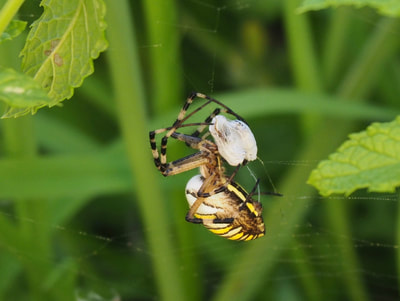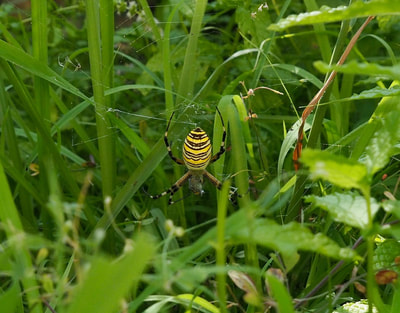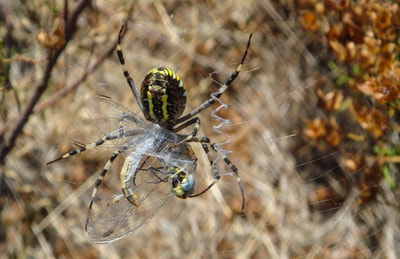I would like to claim that weather conditions and various activities have prevented me from doing much in the garden so far this year, but laziness is really to blame. And I'm now seeing many consequences of this, not the least of which is that once the current heatwave ends, Extreme Gardening will be required - probably for several weeks - to wrestle hedges and borders into submission. On the flipside, neglect is attracting new species.
In the front garden there's a small patch of earth near the garage, where I used to have an almond tree. The tree never exactly flourished just there, and since its demise nothing else has really worked or looked good either, despite irrigation. More recently, quite a few plants have self-seeded, including eleagnus, figwort and mint, so this spring, after digging out some very tough grass, I left it to its own devices. In other words, I was too lazy to sort it out properly.
The other day - yet another sizzler - I went to pick a few mint leaves to flavour a glass of iced water, but the sight of how the mint had spread, that it was in flower and attracting lots of different bees and wasps, had me scurrying back indoors for my camera. After photographing digger and ruby-tailed wasps for a few minutes, I suddenly spotted a yellow and black body lower down in the grass. What I first took to be an enormous hornet turned out to be an enormous (appropriately named) wasp spider spreadeagled in a rather tatty web.
Its French names are either araignée tigre or argiope frelon (tiger or hornet spider) and scientific name is Argiope bruennichi. This is the only time I've seen one since Bruce and I found our first ever, in 2012, while exploring an area on the Spanish side of the Albères. That time the spider was feasting on a dragonfly. I've read that their main prey are grasshoppers and crickets but, in this spot in my garden, it looked as though the menu du jour would be wasp.
I was right. Not long after training my camera on it, a small wasp flew into the web. With lightning speed, the spider grabbed it and wrapped it in sheets of silk. This is to prevent the wasp from stinging, apparently; the likes of grasshoppers and dragonflies don't need wrapping, unless for storage perhaps.
It was interesting, if rather upsetting, that the cocooned wasp continued to struggle for some time. So different from my observations of the crab spider last year, whose ambushed prey quickly succumbed to its paralysing, if not deadly, bite.
The following morning I set up tripod and camera early. In exactly the same spot, the spider - a female, I believe; they're bigger and more brightly coloured than males - was waiting patiently in the centre of a newly-spun web. These usually have a distinctive zigzag pattern near the middle. There wasn't one that day, but Bruce's photo (below right) shows it very clearly. I've been reading up on the purpose of this stabilimentum, and experts seem to be undecided. Two theories are that because it reflects UV light, it may play a role in attracting prey to the web and possibly in preventing its destruction by large animals.
I sat and watched the sunshine creep over the garage roof and across the mint, closer and closer to where She lurked. More insects were arriving every minute, including a couple of Asian hornets at one point. Clearly in search of prey themselves, they quartered the area for a while, often flying low through the grass not far from my spider. Would they be strong enough to extricate themselves from her web? I wasn't to get an answer to that question, but very soon another small wasp did get itself tangled up.
Click photos to enlarge image.
Wasp Spider from Lesley McLaren on Vimeo.


